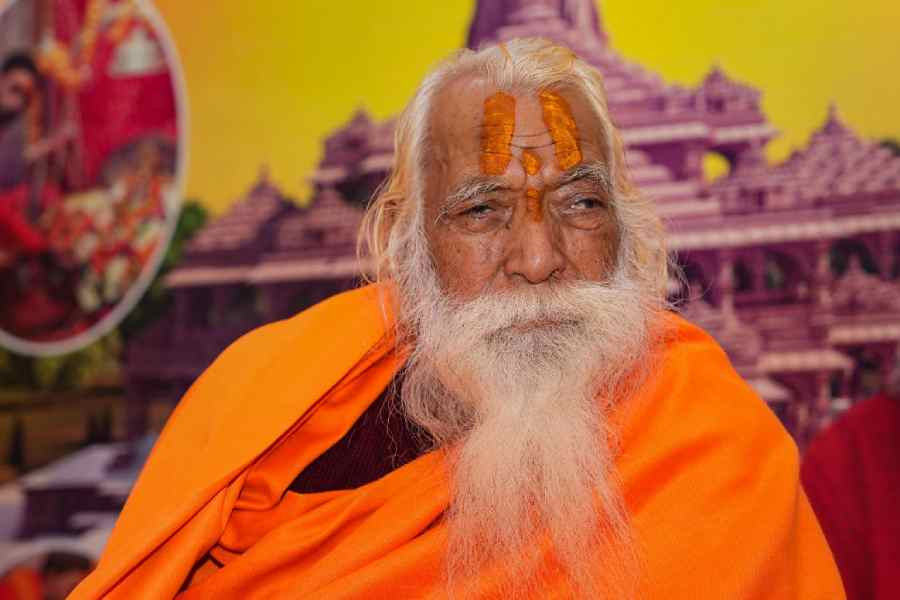Mahant Satyendra Das, the chief priest of the Ram temple for 39 years who never shied away from admitting that he was an eyewitness to the December 1949 “planting” of the Ram idol at the Babri Masjid and remained a lifelong critic of the Ram temple movement, passed away on Wednesday. He was 87.
Satyendra Das was under treatment at the Sanjay Gandhi Post Graduate Institute of Medical Sciences in Lucknow since February 3 after suffering a stroke. The cause of death was stated to be multiple organ dysfunction syndrome.
As an 11-year-old, Satyendra Das had accompanied his would-be guru Abhiram Das when the latter allegedly barged into the Babri Masjid on the intervening night of December 22 and 23, 1949, to “plant” the Ram idol, thus sowing the seeds of the long-drawn Ram temple movement that culminated with the 2019 Supreme Court verdict handing over the disputed Ram Janmabhoomi-Babri land to the Hindus and the construction of the Ram temple in Ayodhya. The movement catapulted the BJP to power and ended up sundering the secular fabric of the country.
Satyendra Das had for years been a vociferous critic of the Ram temple movement and later became reticent on the issue, but never supported the campaign.
While the Hindu Mahasabha, to which Abhiram Das belonged, and later the Vishwa Hindu Parishad always claimed that the idol had “miraculously emerged” as it was Lord Ram’s birthplace, Satyendra Das maintained that it had been planted by his spiritual master.
When a local court in 1986 ordered that Hindus be allowed to pray at the place inside the mosque where the Ram idol was situated, the then Rajiv Gandhi-led Congress government appointed Satyendra Das as the priest. He remained the chief priest of the makeshift Ram temple on the then-disputed land after a VHP-backed mob demolished the Babri Masjid in 1992.
Satyendra Das had told the news agency PTI in an interview in 2022: “I was there. It happened before me. I was witness to it. Of the three (Babri) domes, the north and south domes were demolished by kar sewaks. I carried Ram Lalla along with the throne to safety.”
His continuance as the chief priest of the Ram temple after the Babri fiasco, when the Congress was in power at the Centre, and his criticism of the BJP and the VHP for “politicising” Lord Ram created an impression among certain sections that he had the backing of the Grand Old Party.
However, his oneness with the Ram temple, his unquestioned devotion and the kindness he bestowed upon devotees ensured that he remained the chief priest after the regime change in 2014. When Prime Minister Narendra Modi consecrated the new Ram temple on January 22, 2024, Satyendra Das was appointed its chief priest despite opposition from the VHP.
He had said after the 2019 Supreme Court verdict: “It is good that Lord Ram will be in a temple now. But we love to live in peace and harmony. The court has asked the government to provide land to the Muslim side. We will help them in every possible manner in identifying land and building a mosque.”
Satyendra Das had retired for a few days to his ashram in Hanumangarhi when the government decided to inaugurate the newly built Ram temple. “The government developed cold feet and brought him back to the new temple as chief priest,” a disciple of Satyendra Das said on condition of anonymity.
The disciple added: “He had always chastised Hindutva groups because he believed that they had ditched his guru (Abhiram Das) after provoking him to put the idol in the mosque. However, he resolved in 2024 not to make any critical statement against any person or party.”
Satyendra Das, who took deeksha from Abhiram Das when he was 13, completed the Acharya course from Ayodhya’s Sanskrit College in 1975 and joined the same institute as an assistant teacher the next year.
Premchand Tripathi, one of his disciples, said: “The last rites of Acharya Satyendra Das will be performed in keeping with the tradition of sadhus on Thursday. They are not cremated, they are immersed in the Saryu after a series of rituals.”
Expressing his condolences, Modi wrote on X: “A scholar of religious ceremonies and shastras, the entire life of Mahant Ji was dedicated in the service of Lord Ram.”

